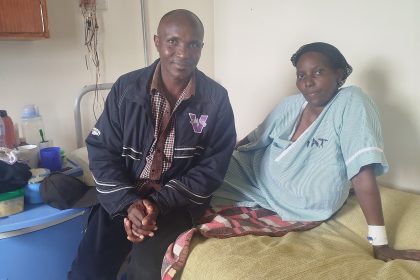Clarity before death among the Luo and Luhya is a sign that the dying person is communicating with ancestors in preparation to join them.
You may have witnessed dying patients who suddenly experience bursts of physical or mental energy in the hours, days, or weeks before death. It seems like a miracle when feelings of grief and despair are replaced with hope and defiance of death.
Take an elderly relative, Mrs Peshua, who had a stroke caused by diabetes and high blood pressure. On that critical Friday night, she went into a coma with vomiting, seizures and lost consciousness. After five days in the ICU, her paralysed right side regained strength, her facial distortion corrected itself, and she opened her eyes wide, searching the room.
Unable to speak, she tried to remove her breathing tube. Then, with sudden clarity, she whispered ‘Huruma’—her only son’s name. She smiled. Then took her final breath.
‘Recovery’ is common among stroke, heart failure, brain tumour, meningitis, and Alzheimer’s patients
Scientists call this phenomenon “terminal lucidity” or an “end-of-life rally.” Terminal lucidity is not considered a medical term, and there is no official consensus on the identifying characteristics. Not everyone approaching death experiences it, but research shows that over 70 per cent of healthcare professionals report witnessing it.
Terminal lucidity is commonly seen in patients with neurological diseases like stroke, heart failure, brain tumours, schizophrenia, multiple sclerosis, meningitis, and Alzheimer’s disease. Recent research also documents cases in non-dementia patients with advanced illnesses like cancer.
The exact cause remains unclear, but medical theories suggest several possibilities:
Neurological Changes: Some researchers believe a surge of brain chemicals like acetylcholine, dopamine, or serotonin may temporarily improve mental clarity. Damaged brain pathways may briefly reactivate, allowing speech and recognition of loved ones.
Reduced Inflammation: Studies suggest that declining brain inflammation near death may allow temporary cognitive recovery.
Metabolic Changes: Changes in blood sugar and oxygen delivery may momentarily improve brain function.
Brain Activity: Gang Xu, a scientist at the University of Michigan’s Department of Molecular and Integrative Physiology, analyzed brain waves (EEGs) of four dying patients before and after their life support was withdrawn. His study found that the dying brain may show increased connectivity and activity, similar to patterns seen in people actively processing information. This research suggests the brain becomes more active, not less, as death approaches, which may explain the heightened consciousness reported in near-death experiences and terminal lucidity cases.
The Luo practice pre-death rituals, including reconciliation, spiritual invocations
Death typically unfolds in three stages:
- Weeks before: The body slows down, the person sleeps more, loses appetite, and withdraws socially
- Days or hours before: Blood circulation weakens, causing cold hands and feet, irregular breathing, and confusion
- Final hours: Consciousness fades, breathing becomes shallow, and the body enters profound stillness
Terminal lucidity often occurs in the second or final stage of death. Studies have found that the brain waves of dying individuals are similar to those of people processing something. Weirdly, brain activity during death shows that oxygen-deprived brains get more active.
In some African cultures, terminal lucidity has spiritual meaning. According to Jane Rose M. Njue in Death, Grief, and Culture in Kenya: Experiential Strengths-based Research, clarity before death among the Luo and Luhya communities is seen as the dying person communicating with ancestors in preparation to join them. The Luo practice pre-death rituals, including reconciliation and spiritual invocations. If terminal lucidity occurs, it confirms the spirit is ready to leave.
Many terminally ill patients report seeing visions of dead loved ones welcoming them to the “next world.” Njue’s research highlights mourning practices such as memorialization and funeral rites among the Luo and death rituals among the Tachoni of Western Kenya, which emphasize maintaining bonds with the deceased.
These practices reinforce that death is not a sudden separation but a transition where the dying person returns to awareness before departing. The Tero Buru ritual after death among the Luo symbolizes the deceased’s continued connection to the living.
Impact on Healthcare: Comfort, dignity, pain management, emotional support
Benefits for Families: Terminal lucidity allows families to reconnect with loved ones, providing opportunities for final conversations and closure, which can ease the grieving process.
Healthcare Adjustments: Providers can adjust care to ensure comfort and dignity during this phase, offering reassurance, pain management, and emotional support tailored to the patient’s needs.
Managing Expectations: Educating families about this phenomenon helps them set realistic expectations and reduces emotional turmoil when their loved one’s condition worsens again.
Ethical Considerations: Some families may seek life-prolonging treatments hoping to sustain their loved one’s clarity. However, such interventions could limit rather than preserve lucidity. Healthcare providers must balance comfort with life extension through careful ethical discussions.
Healthcare Integration: Family involvement in end-of-life care
Kenya’s healthcare system has slowly incorporated cultural sensitivity into palliative care. Organizations like the Kenya Hospices and Palliative Care Association (KEHPCA) and Nairobi Hospice have developed training programmes to educate healthcare workers on culturally responsive care. These programmes focus on understanding patients’ religious and traditional healing preferences, ensuring that end-of-life care respects their values.
KEHPCA and Nairobi Hospice strongly emphasize family involvement in end-of-life care. By acknowledging terminal lucidity, they can encourage families to be present, record final conversations, and find closure through meaningful interactions. Understanding the rituals associated with death allows palliative healthcare workers to offer psychosocial support, honor traditions, and incorporate holistic methods into patient care.
Research gaps to improve end-of-life care strategies
There has been minimal research on terminal lucidity in Kenya or Africa. Kenyan palliative care programmes should research and document cases to better understand frequency and impact. This research could deepen scientific understanding of cognitive function in dying patients and improve end-of-life care strategies.
While no treatments can prolong terminal lucidity, medical practitioners can optimize comfort and brain function during this period:
- Ensuring proper nutrition and metabolic balance
- Providing psychological support and guided conversations
- Helping patients make the most of their lucid moments
Terminal lucidity challenges our understanding of consciousness and dying by showing that cognitive function may not entirely depend on a structurally intact brain. This phenomenon suggests the brain retains capacity for consciousness even in final moments, offering families precious opportunities for connection and closure before their loved one’s departure.
Dr Sharon Wambua is a Pharmacist and Creative Non-Fiction Writer.

























